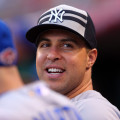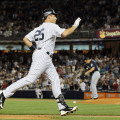By William Copolla
Some fans wonder if the baseballs used last season made to travel further than in previous seasons? Major League Baseball will tell us that there was no difference in the manufacturing of the baseball used last year compared to other years.
In the 90’s MLB execs insisted that no player was using performance enhancing drugs. When Sammy Sosa hit 66 home runs in 1998 followed by 63 bombs in 1999 yet never won a home run title, something was up. To the average fan, something was not quite right.
So, if the ball was “juiced” (something that MLB flacks deny), how would that effect a pitcher’s career? Let’s look at the Atlanta Braves ace Julio Teheran’s performances over the two years in question. This is a pitcher who dominated hitters in 2016 while playing for a last place team that was rebuilding. He was so good that the brain trust of the Braves organization put him in their “Do not touch” box.
He along with perennial all-star first baseman Freddy Freeman were the only players in that organization who were not going to be included in any trade talks as they rebuilt.
2017 saw a different Julio Teheran. He was not the same pitcher as he eventually gave up more runs (103 in 188.1 innings. 33 more than 2016 in the same amount of innings) and watched his ERA go from 3.21 to 4.49. He gave up 22 home runs in the previous year and saw that rise to 33 in 2017. The increase in exit velocity and pitches hit out of the strike zone for hits increased enough to make him an average to below average major league pitcher.
He then began to try to adjust to these hitters which usually requires you to change something in either your mechanics or thinking. Newly hired pitching coach for the Braves this year Chuck Hernandez obviously could not help his young ace figure it out.
The 2016 ball traveled further and then last years regular season ball had lower seams causing spin ratios to be a bit lower and “Bingo,” more home runs. Then MLB brought out their “Play-off ball” in October. It showed the same characteristics as the ball used for the regular season with the added feature of feeling like waxed paper. Unless a pitcher had long strong fingers, they couldn’t get a good grip on the ball.
For an ace like Yu Darvish who has small hands, it became a disaster in the play-offs. He throws hard but relies on his breaking balls for outs. His fastballs were coming in with less movement and were more hittable. Cy Young winner Cory Kluber another pitcher with outstanding breaking balls had similar problems in the post season.
Another problem that a shine-ball gives a pitcher, is that it requires a tighter grip. Squeezing a ball when you throw it at the velocities these guys are capable of, puts more strain on your arm. That means you are looking at potential arm trouble and all for the sake of seeing more home runs.
I hate it when I hear “That’s what the fans want to see, big home runs.” I don’t ever remember seeing polling booths at the turnstiles.
Be prepared for more home run derby games this season because baseball owners are convinced that along with multiple uniform themed promotional days and wacky rule changes, the ball must leave the ballpark as much as possible.
When MVP José Altuve (ho is all of 5’6” and 165 pounds) hits 24 home runs — with some going over 450 feet — in his last 2 seasons for a total of 48 bombs after only hitting a total of 36 in his first five years, either he or the ball is juiced up.
Given the way players are tested for PEDs, I’m going with the baseball being juiced, not the player. Major League Baseball has figured out how to put the ball on steroids.

















Follow Us